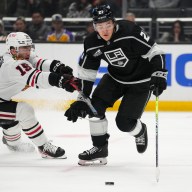There is no question that, since the premiere of James Cameron’s “Avatar,” which grossed $2.7 billion worldwide, 3-D technology has become a major part of Hollywood movies. And the surge in 3-D films has bolstered the box-office draw for all genres, from “Toy Story 3” to Justin Bieber’s doc/concert film, “Never Say Never” — and this weekend’s release of the action epic “Sucker Punch,” which while not in 3-D, commands higher ticket prices as an IMAX film.
With worries about declining theater attendance on the rise as viewers enjoy more options at home, 3-D has created a ray of hope for distributors — at least until 3-D televisions become affordable. It also gives theater-owners the chance to make more money by charging more for 3-D: A single movie ticket for a 3-D presentation in New York City can cost as much as $18. A regular ticket only costs $13.
Cameron, like many, is sticking with the new technology. “I’m going to make all my movies in 3-D, no matter what the subject matter,” he says. “We’ll see if other filmmakers rise to that challenge.”
Other filmmakers certainly appear to be, including veteran horror-movie maestro Wes Craven. “Everything I’m reading about it is that this is not something from the ’50s that they’re just trying again for the hell of it,” Craven says. “I think we’re into a world where 3-D is emerging, and it’s going to be here. I want to be the man that’s on the boat, not standing on the dock when the boat sails away,” he adds.
Tim Burton, whose “Alice in Wonderland” grossed more than $1 billion worldwide, thanks in a large part to 3-D ticket sales, is also on that boat. “It’s not a gimmick,” Burton says. “You could do ‘My Dinner with Andre’ in 3-D.”
But not everyone is jumping on board: Gore Verbinski made a point of not using 3-D for his latest animated feature, “Rango,” starring Johnny Depp. “I don’t think there’s a dimension missing,” he says. “I don’t watch it and go, ‘You know, it’s flat.’ We talked about it early on, and it just didn’t seem like we needed to go there.”
















